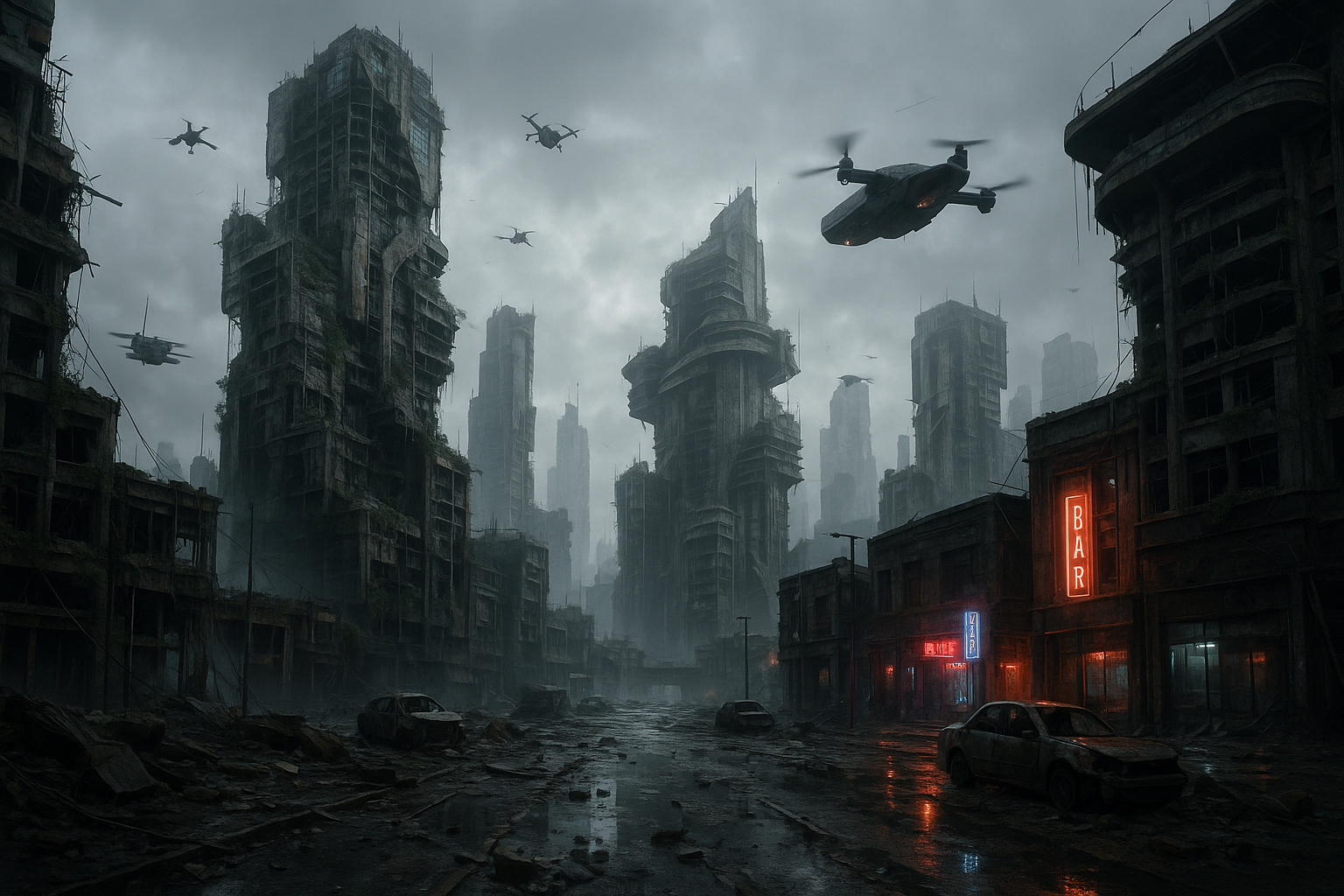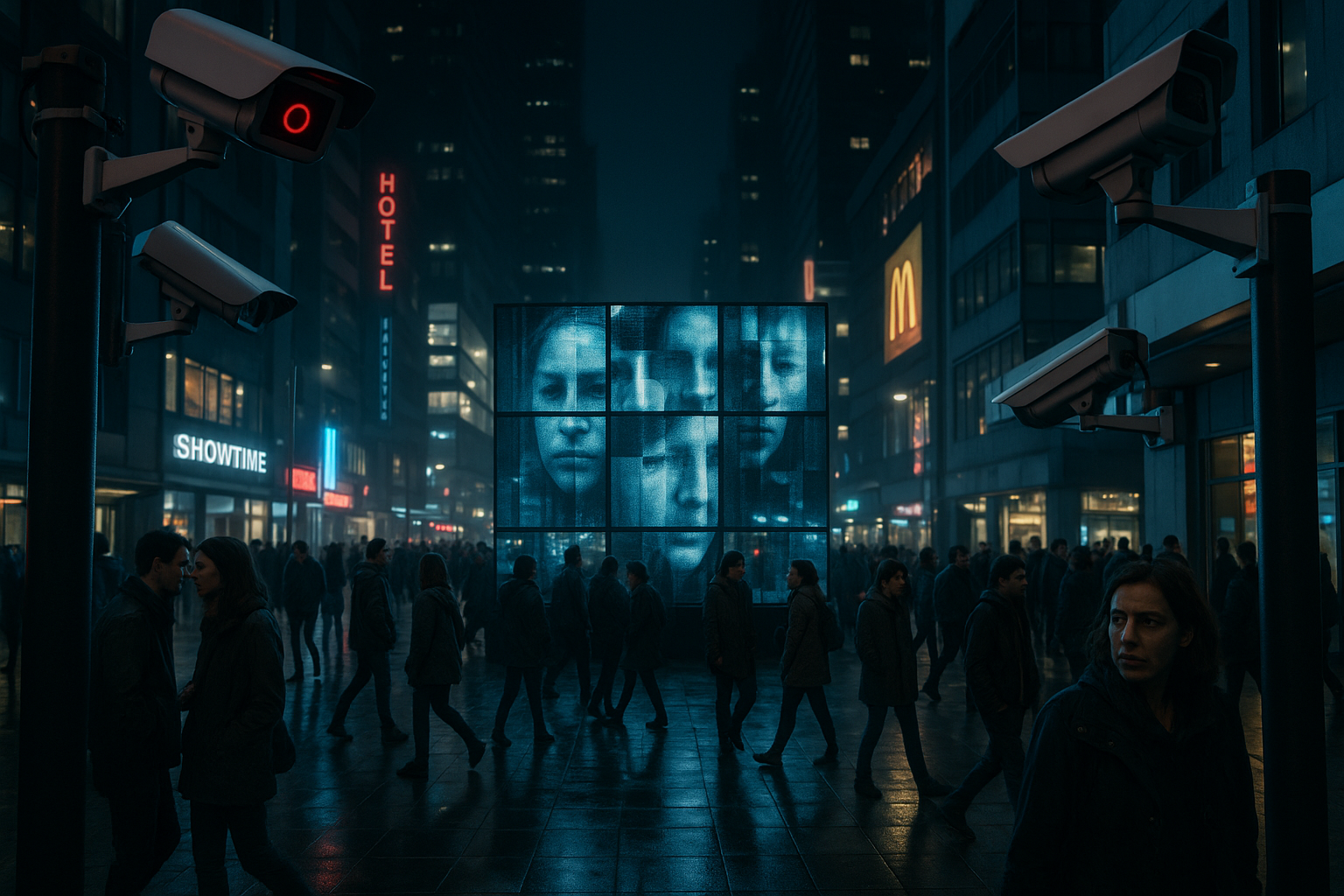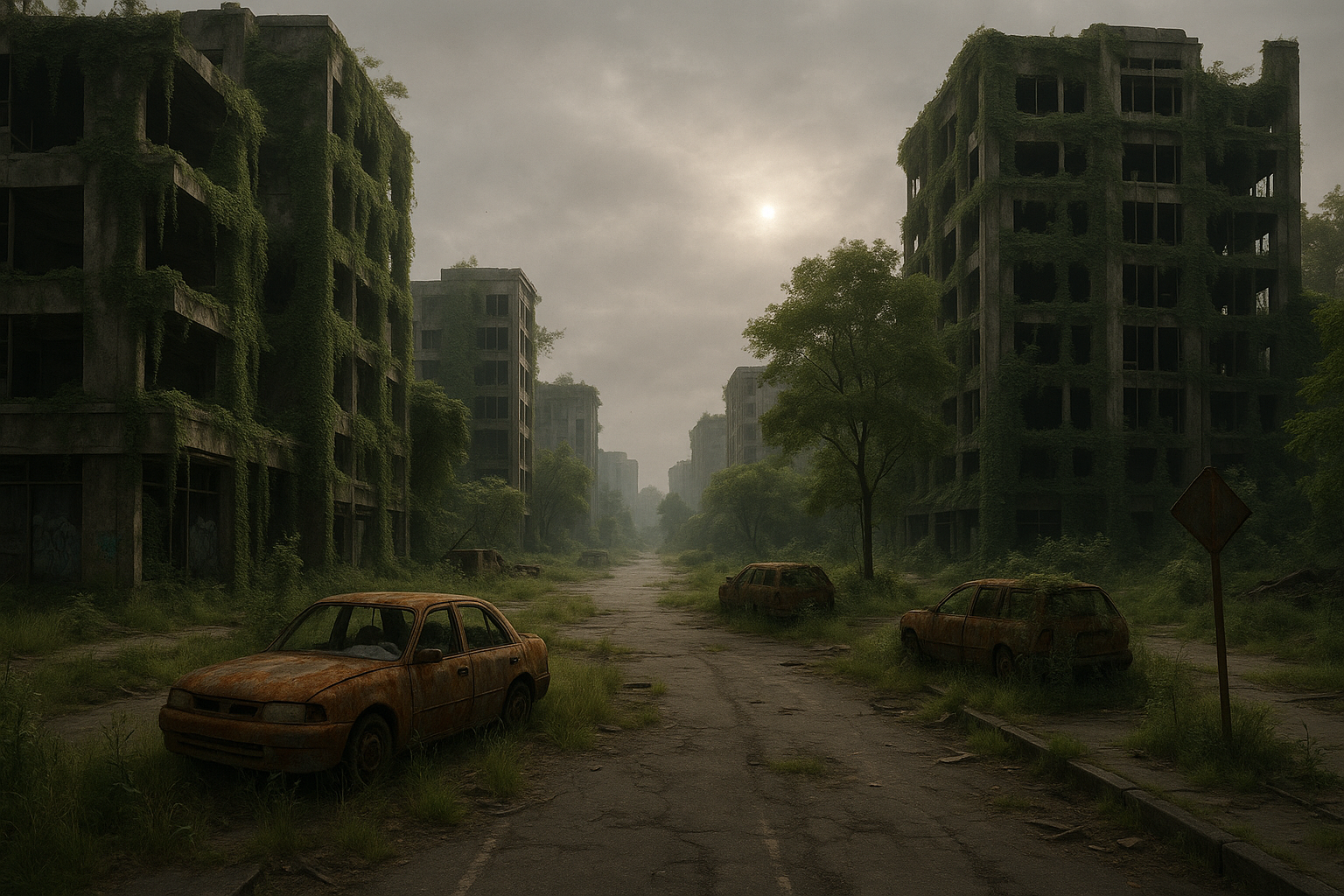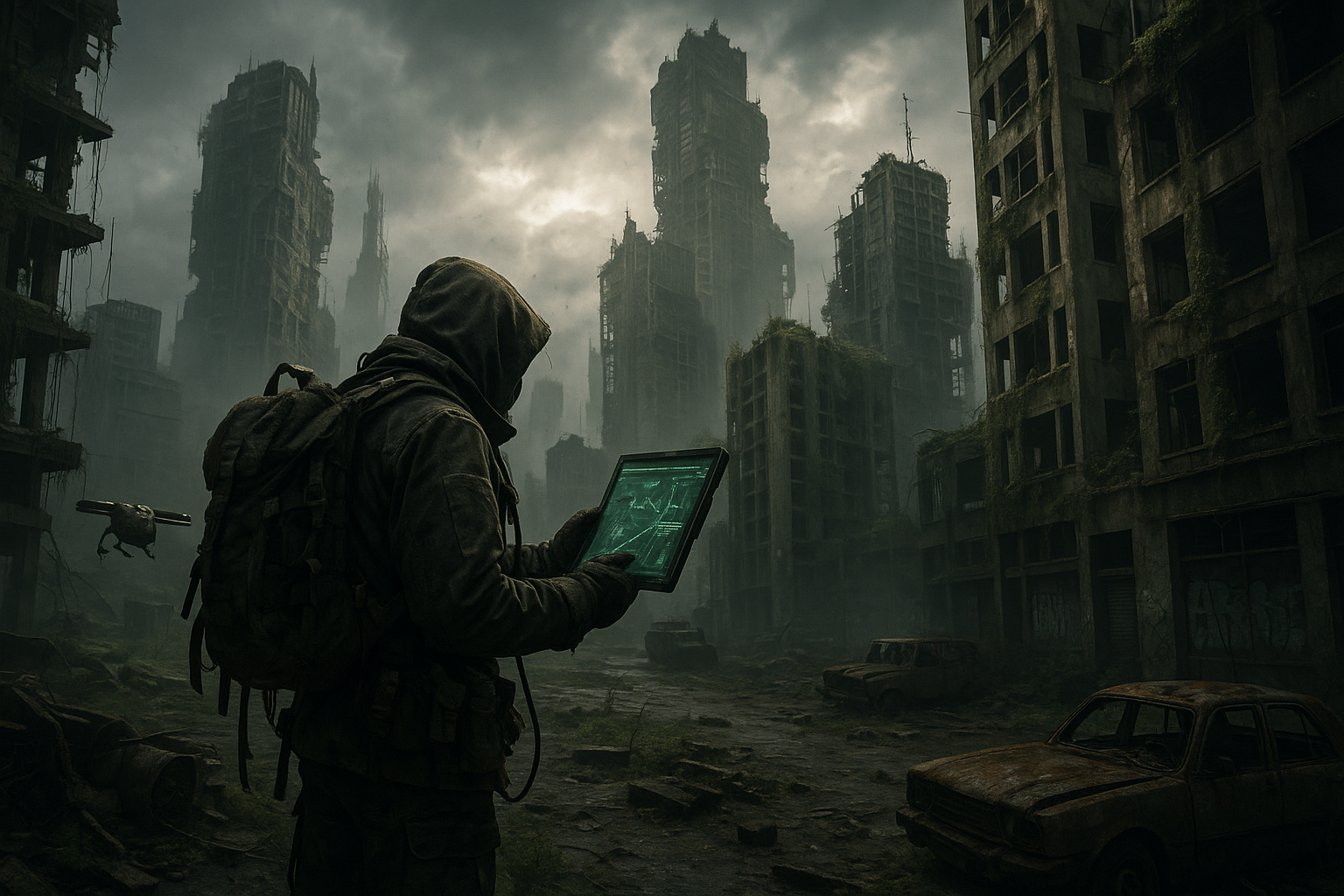Anúncios
In the dimly lit alleyways of a sprawling metropolis, neon lights flicker, casting vibrant hues on the rain-soaked pavement. A holographic advertisement dances above, whispering promises of a cybernetic utopia. Welcome to the world of cyberpunk—a genre that has not only captivated audiences with its dystopian narratives and advanced technology but has also left an indelible mark on the realms of fashion and design. From the sleek, metallic textures of clothing to the gritty, urban landscapes depicted on screen, cyberpunk has revolutionized our perception of the future. But how did this genre, often associated with gritty narratives and philosophical questions, come to influence something as tangible and human-centered as fashion and design? 🌌
Anúncios
To understand this fascinating intersection, we must first explore the origins and defining characteristics of the cyberpunk aesthetic. Emerging in the late 20th century, cyberpunk was born from the rapid technological advancements and cultural shifts of the era. With iconic films like “Blade Runner,” “The Matrix,” and “Ghost in the Shell,” the genre presented a vision of the future that was both alluring and cautionary. These films depicted societies where technology permeated every aspect of life, often blurring the lines between human and machine. Yet, amid the chaos and complexity, there was an undeniable allure—a stylistic coherence that spoke to the possibilities of innovation and transformation. This allure was not lost on the fashion and design industries, which began to incorporate cyberpunk elements into their own narratives.
Anúncios
As we journey through the evolution of this aesthetic, we will delve into the key elements that define cyberpunk fashion and design. Think of the iconic trench coats and sunglasses from “The Matrix,” the blend of traditional Japanese influences with futuristic elements in “Ghost in the Shell,” or the gritty, industrial textures of “Blade Runner.” These films offer more than just visual spectacles; they provide a blueprint for reimagining our own world. We’ll explore how designers have taken inspiration from these cinematic masterpieces, creating clothing lines and architectural designs that echo the cyberpunk ethos. Moreover, we’ll examine how this aesthetic has transcended its niche origins to influence mainstream culture, from haute couture runways to tech-inspired streetwear.
But the story doesn’t end there. The influence of cyberpunk extends beyond fashion and design, challenging us to consider the ethical and philosophical implications of our own technological advancements. In this exploration, we will consider how cyberpunk narratives raise important questions about identity, autonomy, and the future of humanity. As we unravel the threads of this complex tapestry, we invite you to consider how these themes resonate in our present-day society. Are we, too, on the brink of a cybernetic revolution? And if so, how will it shape the way we dress, design, and ultimately, define ourselves? Join us as we uncover the layers of the cyberpunk aesthetic and its profound impact on the future of fashion and design. ✨
The Rise of Cyberpunk: Origins and Influence
The cyberpunk aesthetic has its roots in the 1980s, a decade marked by rapid technological advancements and a burgeoning interest in the digital realm. This aesthetic, characterized by a fusion of high-tech and low-life elements, has been instrumental in shaping both the worlds of fashion and design. The influence of cyberpunk is evident in its iconic films, such as “Blade Runner” and “The Matrix,” which have revolutionized how we perceive the future of fashion and design. These movies not only envision a technologically advanced world but also explore the socio-cultural implications of such advancements. The juxtaposition of neon-lit cityscapes, dystopian settings, and advanced technology creates a unique visual language that has captivated audiences for decades.
The visual style of cyberpunk movies often reflects a world where technology and humanity intersect in unexpected ways. This intersection has deeply influenced fashion designers, who have embraced the aesthetic to create garments that challenge traditional norms. The sleek, metallic fabrics, oversized silhouettes, and futuristic accessories prevalent in cyberpunk-inspired fashion challenge conventional ideas of beauty and style. As the digital age continues to evolve, the cyberpunk aesthetic offers a glimpse into a future where fashion and technology are inextricably linked.
Iconic Cyberpunk Films and Their Impact
Cyberpunk cinema is rich with films that have left an indelible mark on the industry. “Blade Runner,” directed by Ridley Scott, is perhaps the most iconic of these films. Released in 1982, it presents a vision of the future where advanced technology coexists with urban decay. The film’s unique aesthetic has become a benchmark for cyberpunk style, influencing countless designers and filmmakers. The movie’s depiction of a dystopian Los Angeles, with its neon lights and towering skyscrapers, has become synonymous with the cyberpunk genre.
Another pivotal film in the cyberpunk canon is “The Matrix,” directed by the Wachowskis. This 1999 classic explores themes of reality, identity, and control in a digital world. The film’s distinctive visual style, characterized by its green-tinted color palette and bullet-dodging action sequences, has left a lasting impression on audiences worldwide. “The Matrix” not only redefined the cyberpunk aesthetic but also introduced a new generation to the genre, inspiring numerous adaptations and interpretations in various media.
| Film | Release Year | Key Elements |
|---|---|---|
| Blade Runner | 1982 | Dystopian future, advanced technology, urban decay |
| The Matrix | 1999 | Virtual reality, identity, action sequences |
These films, among others, have not only influenced the cyberpunk genre but have also sparked a broader interest in futuristic aesthetics and themes. By challenging viewers to consider the implications of technological advancement, these movies have opened up new avenues for creativity and exploration in fashion and design.
The Cyberpunk Fashion Revolution
The intersection of cyberpunk aesthetics and fashion has given rise to a new wave of design that challenges conventional norms and pushes the boundaries of creativity. Cyberpunk fashion often features elements such as metallic fabrics, neon accents, and bold silhouettes that reflect the genre’s futuristic vision. This style is not just about the visual; it embodies a deeper commentary on society’s relationship with technology and the future.
Cyberpunk fashion is characterized by its embrace of technology as a core element of design. Wearable tech, such as LED accessories and augmented reality garments, are becoming increasingly common in cyberpunk-inspired collections. Designers like Alexander McQueen and Iris van Herpen have incorporated these elements into their work, creating pieces that are as innovative as they are visually stunning. By integrating technology into fashion, these designers are not only redefining what is possible but also challenging the status quo of the fashion industry.
Impact on High Fashion and Streetwear
The impact of cyberpunk on high fashion is evident in the work of designers who have embraced the aesthetic to create groundbreaking collections. Fashion houses such as Balenciaga and Louis Vuitton have incorporated cyberpunk elements into their designs, showcasing collections that feature metallic fabrics, neon accents, and bold silhouettes. These collections not only challenge traditional notions of beauty and style but also highlight the potential of technology in fashion design.
In the realm of streetwear, the cyberpunk aesthetic has become increasingly popular among fashion-forward individuals seeking to make a statement. Brands like Off-White and Vetements have embraced this style, incorporating elements such as oversized silhouettes, bold graphics, and futuristic accessories into their collections. This fusion of high-fashion and streetwear reflects the genre’s influence on contemporary fashion, offering a fresh perspective on style that resonates with the digital generation.
Designing the Future: Cyberpunk’s Architectural Influence
Beyond fashion, the cyberpunk aesthetic has also left its mark on the world of design, particularly in architecture. The futuristic visions presented in cyberpunk films have inspired architects to explore new possibilities in urban design and development. The genre’s emphasis on verticality, neon lighting, and industrial materials has influenced the design of modern cityscapes, resulting in a new wave of architectural innovation.
Cyberpunk architecture often features elements such as towering skyscrapers, illuminated signage, and intricate network systems that reflect the genre’s futuristic vision. These elements create a sense of scale and complexity that is both awe-inspiring and thought-provoking. By embracing the cyberpunk aesthetic, architects are able to explore new design paradigms that challenge conventional notions of space and form.
Innovations in Urban Design
The influence of cyberpunk on urban design is evident in cities around the world, where architects and city planners are exploring new ways to integrate technology into the built environment. Smart cities, characterized by their use of advanced technologies such as AI and IoT, are a testament to the genre’s impact on urban development. These cities leverage technology to improve infrastructure, enhance sustainability, and create more efficient living spaces.
Architects are also exploring new materials and construction techniques inspired by the cyberpunk aesthetic. From adaptive building facades to sustainable construction methods, the influence of cyberpunk is evident in the innovative approaches being used to design the cities of the future. By pushing the boundaries of traditional design, cyberpunk architecture offers a glimpse into a world where technology and creativity coexist in harmony.
Exploring Cyberpunk in Digital Media and Art
The influence of cyberpunk extends beyond fashion and architecture to digital media and art. The genre’s exploration of virtual realities and digital landscapes has inspired a new wave of creativity in digital art and media. Artists and creators are using the cyberpunk aesthetic to explore themes of identity, technology, and the future, resulting in a rich tapestry of visual and narrative experiences.
Digital media, including video games and virtual reality experiences, have embraced the cyberpunk aesthetic to create immersive worlds that challenge players to explore complex themes and narratives. Games like “Cyberpunk 2077” and “Deus Ex” offer players the opportunity to explore richly detailed worlds where technology and humanity intersect in unexpected ways. These games not only provide entertainment but also offer a commentary on the potential future of society in a digital age.
The Role of Cyberpunk in Contemporary Art
In the realm of contemporary art, the cyberpunk aesthetic has inspired artists to explore new mediums and techniques. From digital installations to virtual reality experiences, artists are using the cyberpunk aesthetic to push the boundaries of what is possible in art. These works often explore themes of identity, technology, and the future, offering viewers a unique perspective on the world around them.
Artists like Beeple and Refik Anadol have embraced the cyberpunk aesthetic in their work, creating pieces that are both visually stunning and thought-provoking. By exploring the intersection of technology and art, these artists are challenging traditional notions of creativity and expression, paving the way for a new era of digital art.

Conclusion
In conclusion, the exploration of the cyberpunk aesthetic reveals its profound impact on the realms of fashion and design, illustrating a dynamic interplay between technology, culture, and creativity. Throughout this article, we delved into the origins and evolution of the cyberpunk genre, tracing its roots back to seminal films like “Blade Runner,” “The Matrix,” and “Ghost in the Shell.” These cinematic masterpieces not only redefined the boundaries of storytelling but also set the stage for a revolutionary approach to visual aesthetics that continues to inspire designers and artists across the globe.
The cyberpunk aesthetic is characterized by its bold, dystopian imagery, blending elements of high-tech futurism with gritty, urban environments. This juxtaposition creates a unique visual language that challenges conventional notions of beauty and design. We examined how this aesthetic has permeated the fashion industry, influencing designers to experiment with unconventional materials, asymmetrical silhouettes, and technological integrations. From high-fashion runways to streetwear brands, the cyberpunk style has become a staple of contemporary fashion, encouraging a forward-thinking approach that embraces the merging of human and machine.
Moreover, the impact of cyberpunk on design extends beyond clothing to encompass architecture, product design, and digital art. The futuristic cityscapes depicted in these films have inspired architects to envision urban environments that prioritize technology and sustainability. Similarly, product designers draw inspiration from cyberpunk’s emphasis on functionality and innovation, creating items that are not only visually striking but also enhance the human experience through technological advancements.
The thematic elements of cyberpunk, such as the exploration of identity, surveillance, and the ethics of artificial intelligence, resonate deeply with today’s societal challenges. As we navigate an increasingly digital world, these narratives prompt us to reflect on the implications of our technological advancements and their impact on our lives. The cyberpunk aesthetic serves as a mirror, reflecting our hopes and fears about the future, urging us to consider the kind of world we wish to create.
The enduring influence of the cyberpunk aesthetic is a testament to its ability to capture the imagination and inspire change. It challenges us to push the boundaries of creativity, to envision a future that is not only technologically advanced but also inclusive and sustainable. By embracing the principles of cyberpunk, designers and creators are empowered to innovate, to think critically about the intersection of technology and humanity, and to craft experiences that resonate on a profound level.
We encourage you, the reader, to engage with the themes and ideas presented in this article. Reflect on how the cyberpunk aesthetic influences your perception of the future and consider how you might incorporate its principles into your own work or lifestyle. Whether you’re a designer, artist, or simply an enthusiast of futuristic aesthetics, there’s much to learn and explore within the realm of cyberpunk.
Feel free to share your thoughts and insights in the comments section below. Let’s continue the conversation and explore how the cyberpunk aesthetic can inspire us to create a future that is both imaginative and meaningful. Share this article with others who might be intrigued by the intersection of fashion, design, and technology, and let’s expand this community of forward-thinkers and innovators.
For further exploration into the fascinating world of cyberpunk and its influence, consider checking out resources such as the “Cyberpunk Culture: From Sci-Fi to the Fashion Industry” article on Vogue, or delve into the academic perspectives with “Cyberpunk and Visual Culture” available through JSTOR. These resources offer deeper insights into the themes we’ve discussed and provide a broader context for understanding the significance of the cyberpunk aesthetic in our contemporary world.
In conclusion, the cyberpunk aesthetic is not just a visual style; it’s a cultural movement that challenges us to envision a future where technology and humanity coexist harmoniously. Let’s embrace its spirit of innovation and creativity as we navigate the ever-evolving landscape of fashion and design. The future is cyberpunk, and it’s ours to shape. 🚀
Toni Santos is a visual storyteller and artisan whose work reimagines fashion in the aftermath of civilization. Exploring the aesthetics of survival, decay, and resilience, Toni crafts wearable narratives shaped by a post-human world — where utility meets myth, and remnants become ritual.
Drawn to the raw beauty of collapse and adaptation, Toni’s creations emerge from imagined futures and forgotten pasts. Torn fabrics, corroded metals, and salvaged textures form the foundation of a style that speaks not just to what is worn — but to what has endured. Each piece tells a story of transformation, of identity reshaped by ruins and time.
Through garments, accessories, and visual compositions, Toni constructs a language of dress where fashion is not decoration but declaration — a symbol of survival, memory, and the human spirit persisting in desolation. With a background in visual design and handcrafted techniques, Toni blends precision with provocation. His works are tactile philosophies, designed to be worn, felt, and remembered.
As the creative voice behind Vizevex, Toni shares a vision of fashion as post-civilization mythology — offering curated collections and visual essays that explore the line between relic and garment, artifact and identity.
His work is a tribute to:
The resilience encoded in fabric and form
The symbolic armor we craft in the face of extinction
The beauty found in fragmentation, rust, and reassembly
Whether you are an artist, a futurist, or someone drawn to the aesthetics of survival and reinvention, Toni invites you into a world where fashion becomes memory — one stitch, one scar, one future at a time.





